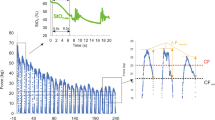Abstract
This study aimed to investigate the relationship between muscle hardness and muscle tension in terms of length–tension relationship. A frog gastrocnemius muscle sample was horizontally mounted on the base plate inside a chamber and was stretched from 100 to 150% of the pre-length, in 5% increments. After each step of muscle lengthening, electrical field stimulation for induction of tetanus was applied using platinum-plate electrodes positioned on either side of the muscle submerged in Ringer’s solution. The measurement of muscle hardness, i.e., applying perpendicular distortion, was performed whilst maintaining the plateau of passive and tetanic tension. The relationship between normalised tension and normalised muscle hardness was evaluated. The length–hardness diagram could be created from the modification with the length–tension diagram. It is noteworthy that muscle hardness was proportional to passive and total tension. Regression analysis revealed a significant correlation between muscle hardness and passive and total tension, with a significant positive slope (passive tension: r = 0.986, P < 0.001; total tension: r = 0.856, P < 0.001). In conclusion, our results suggest that muscle hardness depends on muscle tension in most ranges of muscle length in the length–tension diagram.









Similar content being viewed by others
References
Alamaki A, Hakkinen A, Malkia E, Ylinen J (2007) Muscle tone in different joint positions and at submaximal isometric torque levels. Physiol Meas 28:793–802
Ashina M, Bendtsen L, Jensen R, Sakai F, Olesen J (1999) Muscle hardness in patients with chronic tension-type headache: relation to actual headache state. Pain 79:201–205
Epstein M, Herzog W (1998) Theoretical models of skeletal muscle. Wiley, New York, pp 52–57
Fischer AA (1987) Clinical use of tissue compliance meter for documentation of soft tissue pathology. Clin J Pain 3:23–30
Gennisson JL, Cornu C, Catheline S, Fink M, Portero P (2005) Human muscle hardness assessment during incremental isometric contraction using transient elastography. J Biomech 38:1543–1550
Gubler-Hanna C, Laskin J, Marx BJ, Leonard CT (2007) Construct validity of myotonometric measurement of muscle compliance as a measure of strength. Physiol Meas 28:913–924
Higuchi H (1992) Changes in contractile properties with selective digestion of connectin (titin) in skinned fibers of frog skeletal muscle. J Biochem 111:291–295
Horikawa M, Ebihara S, Sakai F, Akiyama M (1993) Non-invasive measurement method for hardness in muscular tissues. Med Biol Eng Comput 31:623–627
Kawakami Y, Lieber RL (2000) Interaction between series compliance and sarcomere kinetics determines internal sarcomere shortening during fixed-end contraction. J Biomech 33:1249–1255
Leonard CT, Deshner WP, Romo JW, Suoja ES, Fehrer SC, Mikhailenok EL (2003) Myotonometer intra- and interrater reliabilities. Arch Phys Med Rehabil 84:928–932
Leonard CT, Brown JS, Price TR, Queen SA, Mikhailenok EL (2004) Comparison of surface electromyography and myotonometric measurements during voluntary isometric contractions. J Electromyogr Kinesiol 14:709–714
MacIntosh BR, MacNaughton MB (2005) The length dependence of muscle active force: considerations for parallel elastic properties. J Appl Physiol 98:1666–1673
Maruyama K (1997) Connectin/titin, giant elastic protein of muscle. FASEB J 11:341–345
Morisada M, Okada K, Kawakita K (2006) Quantitative analysis of muscle hardness in tetanic contractions induced by electrical stimulation in rats. Eur J Appl Physiol 97:681–686
Murayama M, Nosaka K, Yoneda T, Minamitani K (2000) Changes in hardness of the human elbow flexor muscles after eccentric exercise. Eur J Appl Physiol 82:361–367
Murayama M, Yoneda T, Kawai S (2005) Muscle tension dynamics of isolated frog muscle with application of perpendicular distortion. Eur J Appl Physiol 93:489–495
Sakai F, Ebihara S, Akiyama M, Horikawa M (1995) Pericranial muscle hardness in tension-type headache. A non-invasive measurement method and its clinical application. Brain 118:523–531
Steinberg BD (2005) Evaluation of limb compartments with increased interstitial pressure. An improved noninvasive method for determining quantitative hardness. J Biomech 38:1629–1635
Woittiez RD, Huijing PA, Rozendal RH (1983) Influence of muscle architecture on the length-force diagram of mammalian muscle. Pflugers Arch 399:275–279
Author information
Authors and Affiliations
Corresponding author
Additional information
Communicated by Arnold de Haan.
Rights and permissions
About this article
Cite this article
Murayama, M., Watanabe, K., Kato, R. et al. Association of muscle hardness with muscle tension dynamics: a physiological property. Eur J Appl Physiol 112, 105–112 (2012). https://doi.org/10.1007/s00421-011-1959-3
Received:
Accepted:
Published:
Issue Date:
DOI: https://doi.org/10.1007/s00421-011-1959-3




